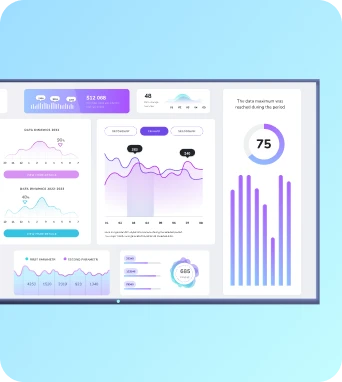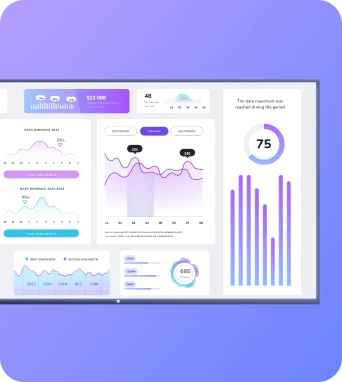SaaS KPIs are kinda like snacks at a board meeting — there are always way too many, most aren’t that good, and the vast majority are the same thing with slightly different flavors. 🍨
I'm saying this because I don't think SaaS teams are overwhelmed by the lack of snacks (er, KPIs). They just don’t know which metrics actually matter. How do you know if you’re tracking good ones? What if you spend hours exporting KPI reports that never get read?
To ensure that it never happens to you, this guide covers the 11 SaaS KPIs that are actually useful for SaaS companies. You’ll learn how to measure, benchmark, and address them with your team so you can stop feeling stuck and start focusing on growth.
What are SaaS KPIs?
SaaS stands for software as a service. This is any business offering access to a digital system, like Microsoft 365, or Google Workspace, or Fugo. 😉
KPI stands for key performance indicator. This is essentially a measure of business performance that lets you make better decisions about how to improve your path forward.
So a SaaS KPI is any measure of business performance that is specifically valuable to a SaaS business model.
There are (quite literally) hundreds of KPIs available to measure, from customer lifetime value to monthly recurring revenue to everything in between. So the trick is finding the most useful KPIs to track the growth and success of your SaaS business over time.
The 11 most important SaaS KPIs
Just tracking more metrics doesn’t make you more data-driven. In some situations, it could make you even more distracted — the last thing you need as a fast-growing SaaS business.
But fear not! We’ve already done the heavy lifting for you by compiling a list of the 11 most important SaaS KPIs.
Let’s take a deeper dive into each individual KPI:
1. Monthly recurring revenue (MRR)
MRR is perhaps one of the most important SaaS metrics for tracking, since it tells you how much predictable revenue your business generates each month (aka, how much money you can reasonably expect to come in on a regular basis).
Tracking MRR helps you understand whether your SaaS business is boosting its total revenue, or if it needs another look at the business model. It also gives you a clear view of revenue trends and serves as a foundation for forecasting, planning headcount, and deciding when to invest in new features or tools.
How to calculate MRR
To calculate MRR, use this simple formula:
Total number of paying users X average revenue per user or account = MRR
Let’s say you have 200 paying customers and they each pay $50 per month. That means your MRR would be $10,000.
Note: If you have multiple subscription tiers (like Pro and Enterprise), you may want to calculate MRR separately for each tier, then add them together.
You can also go deeper by calculating New MRR, Expansion MRR (from upgrades), and Churned MRR (from cancellations) to get a more nuanced understanding of your monthly revenue flow.
MRR benchmarks for SaaS
There’s no one-size-fits-all answer here, but here’s a quick gut check:
- Early-stage SaaS startups: Aim to hit $1K to $10K MRR as quickly as possible.
- Post-product-market fit: Growing toward $100K MRR puts you on track for a healthy Series A trajectory.
- Established SaaS companies: Benchmarks vary widely, but healthy growth is usually tied to low churn and a strong net revenue retention rate (more on that soon).
How to fix a bad MRR
There are four classic levers for increasing MRR:
- Acquire more monthly active users (duh).
- Increase average revenue per account with upsells, premium features, or pricing strategy updates.
- Reduce churn to keep existing MRR intact. We’ll cover more of this later.
- Offer compelling upgrades. Whether it’s new features, annual plans, or bundled services, there's usually more value you can unlock with the audience you already have.
Keep in mind you can also use tools like Baremetrics and ProfitWell to track MRR and related metrics in real time. You can also use AI dashboards to monitor trends and forecast revenue based on historical patterns — no spreadsheet wrangling required. 😎
2. Customer lifetime value (CLTV)
CLTV (also written as CLV) estimates how much revenue a single customer brings to your business over the course of their relationship with your brand.
If your customers cost more to acquire than they’re worth, you probably don’t have a sustainable business model. But if you can see your CLTV is high and CAC, you’ve clearly got a recipe for scalable growth.
Let’s break it down.
How to calculate CLTV
There are a few ways to calculate CLTV, but the most straightforward method looks like this:
Customer Lifetime Value = ARPU (average revenue per user) × customer lifespan
So if your customers pay $50 per month and stay for 24 months on average, your CLTV would be $1,200.
If you want to account for both margin and churn, you can also calculate CLTV as:
CLTV = (average revenue per user × Gross Margin %) / churn rate
CLTV benchmarks for SaaS
This, of course, depends on your industry.
For a B2B financial advice firm, customer lifetime value might hover around $164,000
For a software company CLTV, it might be closer to $240,000.
Don’t forget that business age and size can also be factors. You just want to make sure your CAC and CLV ratios look good.
Again, a healthy CLTV:CAC ratio is typically 3:1. That means for every dollar you spend acquiring a customer, they should generate about three dollars in lifetime value.
How to fix a bad CLTV
If your CLTV is looking a little bleak, don’t panic. Here are a few ways to increase it:
- Improve retention. Longer retention often leads to a higher CLTV. To do this, try focusing on onboarding, support, and customer success.
- Upsell and cross-sell. You might offer additional value through new features, service tiers, or related products. Whatever makes sense for your business.
- Reduce churn. If you’re losing customers early, try looking at friction points in the onboarding or subscription experience.
- Segment your customers. Not all customers are created equal. By focusing on your most valuable segments, you can tailor pricing and support to boost overall CLTV.
3. Customer acquisition cost (CAC)
You probably already know it costs more money to get new customers than to retain existing customers. That’s one of the things customer acquisition measures: how much it costs to acquire a new customer.
If your CAC is too high, your funnel might be leaky, or you might be spending too much to win new users. Combine this with CLTV (see above), and you’ve got one of the most important financial health indicators in SaaS.
How to calculate CAC
You can calculate customer acquisition cost (CAC) with the following formula:
CAC = Total sales and marketing spend / number of new customers acquired
So if you spend $100,000 on sales and marketing in one quarter and acquire 500 customers, your CAC is $200.
CAC benchmarks for SaaS
Again, this all depends on the size of your business, industry, and customer type.
But here’s a quick chart breaking it down so you can set metrics at a glance:
How to fix a bad CAC
If your CAC is too high, consider sniffing around your conversion rates. This means optimizing landing pages, fixing email nurture flows, and keeping an eye on demo processes to turn more leads into customers.
You might also focus on acquiring customers via tools for organic growth. SEO, content marketing, and referrals usually cost less than paid ads, after all.
Finally, look for ways to optimize your ICP. If you’re targeting the wrong people, your CAC will always be higher than it needs to be. The side effect of this might be shortening your sales cycle: and the faster you close deals, the lower your CAC will become.
4. CAC payback period
Now that you know your CAC, you can calculate your CAC payback period — basically how long it takes to earn that money back.
It measures the number of months it takes for your business to recover its customer acquisition costs from monthly gross profit.
If it takes too long to break even, you may run into cash flow issues. There are, thankfully, a few simple ways to manage this.
How to calculate CAC payback period
Here’s the standard formula:
CAC Payback Period = CAC / monthly gross margin per customer
Let’s say your CAC is $400 and your average customer brings in $100 per month in revenue.
You can calculate your monthly gross margin per customer with this formula:
Gross margin per customer = Gross yearly profit from customer / Revenue costs per customer x 100
For the purposes of this example, let's say you have a 70% gross margin, or $70 in monthly gross profit.
So, your CAC payback period would be:
$400 CAC / $70 monthly gross margin = ~5.7 months
That means it will take you almost six months to break even on each new customer.
CAC payback period benchmarks for SaaS
The average benchmark for CAC payback depends on the size of your business.
In general, though, if you’re an SMB between 20 and 100 employees, your CAC payback should be somewhere between four and seven months.
You can refer to this chart from ScaleEP to get the whole story:
How to fix a bad CAC payback period
If your CAC payback period is dragging on, try these strategies:
- Raise prices or increase ARPU. This directly boosts your gross profit per customer and shortens the payback period.
- Improve onboarding and activation. The faster customers see value, the less likely they are to churn, and the faster you can start recovering costs.
- Cut your CAC. Go back to your acquisition strategies and see where you can trim spend or increase efficiency.
- Improve your margins. Can you deliver your product more efficiently, or reduce costs associated with service delivery?
5. Customer churn rate
Customer churn rate refers to the number of customers lost after unsubscribing or canceling their accounts with your SaaS business. With it, you can calculate the number of paying customers compared to the number of customer accounts that get canceled every year.
Understanding your churn rate can help you better understand business growth, how fast your company is growing, and whether or not you’re unintentionally ‘shedding’ customers. The good news is, it’s fairly easy to track with a KPI dashboard. We’ll talk through a few ways to calculate it, set benchmarks, and recover below.
How to calculate churn rate
You can calculate revenue churn with the following equation:
Number of accounts churned in time period / number of all accounts at the beginning of same time period x 100 = customer churn
That means if you lost 15 customer accounts last year out of 250 total accounts at the beginning of the year, your customer churn rate is 6%.
Churn rate benchmarks for SaaS
The average benchmarks for customer churn rates are heavily dependent on your SaaS focus and industry. For example, energy and utility companies usually see a very low churn rate of 11% or less. Others like logistics and consumer packaged goods (CPG) can have rates as high as 40%.
In general, though, B2B SaaS should focus on less than 5% churn per year, while B2C SaaS should aim for less than 8% per year.
How to fix a bad churn rate
One way to lower your customer churn rate is with tools like ChartMogul, which offers cohort analysis among customer segments so you can track down strategies for customer retention.
Also, remember that customer retention gets much easier when you increase customer engagement. So if you can brainstorm engagement ideas, you will likely improve retention going forward.
Not sure how to work on retaining customers? You can always start from the inside out by focusing on engaging your employees.
6. Net revenue retention (NRR)
Net revenue retention (NRR) helps you calculate how much revenue you’re generating without acquiring any new customers. It accounts for upgrades, downgrades, churn, and expansion revenue across your existing customer base.
That makes it one of the best indicators of how strong your product-market fit really is.
How to calculate NRR
Here’s the formula:
NRR = (Starting MRR + Expansion – Contractions – Churn) / Starting MRR x 100
Let’s say you started the month with $100,000 MRR, gained $15,000 in expansion, lost $5,000 to churn, and $3,000 to downgrades. Your formula would be:
($100,000 + $15,000 – $5,000 – $3,000) / $100,000 x 100 = 107%
A 107% NRR means your revenue base grew even without new customers.
NRR benchmarks for SaaS
Your net revenue retention also depends on your annual contract value (ACV), which is a measure of the average value of a customer subscription.
If your ACVs are less than $12,000 in value, your NRR should be around 100%.
But if your ACVs are greater than $250,000, your NRR should be up to 110%.
Learn more about how GRR rates should hover around 91% for a growing SaaS business.
How to fix a bad NRR
A few ideas for fixing a low NRR rate:
- Reduce churn with better onboarding, support, and proactive customer success.
- Identify downgrade patterns. Find out why customers are using less and respond before they churn altogether.
- Introduce usage-based pricing or add-on features that scale with customer success.
- Double down on expansion revenue.
Which leads straight into our next point…
7. Expansion revenue
Expansion revenue tracks all the extra revenue you earn after acquiring a new customer, whether it’s from upsells, cross-sells, add-ons, or increased usage.
It’s also a huge part of your NRR, and one of the fastest ways to grow without needing new leads.
How to calculate expansion revenue
It’s pretty simple:
Expansion revenue = All revenue from existing customers this period – their original contract value
For example, if a customer originally signed up at $5,000 per year but has grown to paying $7,500 per year, that’s $2,500 in expansion revenue.
Expansion revenue benchmarks for SaaS
Studies show that growing SaaS businesses have an expansion revenue (MMR) rate between 10% and 30%.
TL;DR: as long as your expansion revenue rate is higher than your churn rate, you're likely growing at a sustainable pace.
How to fix a bad expansion revenue
Some options:
- Offer usage-based pricing. Let customers grow into your product (and pay accordingly).
- Launch premium features. Give existing users a compelling reason to upgrade.
- Create seamless upgrade paths. Don’t make customers hunt for how to expand. Instead, make it obvious, frictionless, and easy to do while they’re in the thick of things (aka, using your product).
8. Lead velocity rate (LVR)
Lead Velocity Rate measures the growth rate of qualified leads month-over-month. It’s also a leading indicator of future revenue: because if your pipeline is growing, your revenue should follow suit.
How to calculate LVR
Use this formula:
LVR = ((# of qualified leads this month – # of qualified leads last month) / last month’s leads) × 100
Let’s say you had 300 qualified leads last month, and 360 this month. That would be a formula of: LVR = ((360 – 300) / 300) × 100 = 20%
And also shows you’re on track for growth.
LVR benchmarks for SaaS
Most growing B2B SaaS companies should aim for a 15% to 30% monthly LVR. Lower than that, and you might be taking too long to hit your goals. Higher than that, and you might double check your lead quality. Just in case. 😉
How to fix a bad LVR
Here are some rules of thumb to try:
- Revisit your lead gen channels. If organic search and outbound aren’t scaling, try partnerships or PLG incentives.
- Qualify more tightly. Don’t just grow lead volume, grow qualified lead volume.
- Automate your top-of-funnel. Use AI, better forms, and CRM integrations if necessary.
9. Magic number
No, we’re not just being cute. This is a bona-fide metric. It’s called the magic number because when it’s good, it feels like, well, magic.
The SaaS “magic number” helps you understand how efficiently your sales and marketing spend translates into new revenue. If you can prove every dollar spent on sales and marketing leads to an annual recurring revenue increase, you’re bound to feel a whole lot better about upping the budget for your marketing team.
How to calculate the magic number
The SaaS magic number formula is:SaaS Magic Number = ((Quarter GAAP revenue – previous quarter GAAP revenue) x 4) / (Previous quarter's sales and marketing spend)
Say your GAAP revenue went from $1M to $1.3M, and your sales and marketing spend last quarter was $500K. This would be an equation of:
((1.3M – 1M) × 4) / 500K = (0.3M × 4) / 0.5M = 1.2M / 0.5M = 2.4
This means you’re making $2.40 in revenue for every $1 spent on growth.
Magic number benchmarks for SaaS
If your magic number is less than 0.5, there may be issues with churn, cost per customer, or pricing (aka, selling yourself short).
If your magic number is less than 0.75, it may be too heavy on sales and marketing efforts.
Anything higher than a 0.75 means you’re likely bringing on new and existing customers for a reasonable cost. It also means the revenue generated per new customer is acceptable and is currently supporting your business growth.
How to fix a bad magic number
As you might imagine, it requires you to go back to the basics:
- Audit your sales and marketing funnel. Where are leads dropping off? What’s working?
- Improve onboarding. Where are people getting stuck?
- Increase pricing or expand revenue per customer. Sometimes, you’re just undercharging.
10. Sales cycle length
Sales cycle length measures how long it takes your team to convert a lead into a paying customer. The longer it takes, the more time, money, and effort you spend getting to the finish line. The shorter it takes, the quicker you get paid.
Let’s look at some ways to keep your numbers as low as possible.
How to calculate sales cycle length
Add up the number of days from first contact to closed for each deal in a set period. Then, divide by the number of deals in that same time frame.
This means:
Sales Cycle Length = Total # of Days to Close Deals / Total # of Closed Deals
If five deals in a month took 60, 70, 85, 100, and 95 days respectively, your average sales cycle for that month would be:
(60 + 70 + 85 + 100 + 95) / 5 = 82 days
Sales cycle length benchmarks for SaaS
In SaaS, the average sales cycle length lasts around 84 days, which is approximately 2.8 months.
Keep in mind this might be shorter if you serve other businesses only. According to Databox, the median value of a B2B sales cycle length is approximately 2.1 months.
How to fix a bad sales cycle length
There’s no one-size-fits-all solution here, but you might try:
- Qualifying leads more tightly at the top of the funnel.
- Automating repetitive tasks like follow-ups and proposal generation to spend more time building relationships with customers.
- Creating sales enablement content that answers common objections ahead of time.
- Shortening the buying journey by offering self-serve trials or demo videos.
11. Average revenue per account (ARPA)
ARPA tells you how much revenue you’re generating per customer account on average, usually tracked monthly. The goal is to help you better understand customer value, including how much each one contributes to your bottom line.
How to calculate ARPA
It’s probably easier than you think. Don’t believe us? Try:
ARPA = Total MRR / Total Number of Customer Accounts
Let’s say you have $100,000 in monthly recurring revenue and 250 customers. This means your ARPA = $100,000 / 250 = $400.
This means your customer acquisition costs must be less than $400 each to ensure you’re making money at the end of the day.
ARPA benchmarks for SaaS
This one isn’t really easy to benchmark, since every SaaS business has their own method of generating revenue.
In general, though, you should probably fall somewhere between $25 per month and $1,000 per month. The number should give you a pretty good idea of how many customers you need to break even in a certain time period.
We can say that different types of businesses have different types of growth rates. For example, B2C SaaS companies tend to grow faster than B2B SaaS based on ARPA.
So be sure to temper your expectations and set measurable goals for your MRR and ARR.
How to fix a bad ARPA
If your ARPA is low, that’s not necessarily a red flag, but it’s worth comparing it to your CAC, churn rate, and LTV to get the full picture.
Not happy with what you see? Try these strategies on for size:
- Upsell and cross-sell to increase account value
- Introduce tiered pricing with premium features (if you haven’t already)
- Retire unprofitable features and shift focus to high-value accounts
- Use segmentation to target customers with a higher willingness to pay
Wait a sec: what about all the other SaaS metrics?
Remember: this roundup is all about detailing the 11 most useful SaaS KPIs, and not necessarily every metric under the sun. That’s because we don’t want you to feel like you’re throwing spaghetti at the wall. There are plenty of SaaS metrics out there, and honestly, you really only need two-ish handfuls to track everything correctly.
But if you’re still reading this and hungry for more, don’t worry, we got you. 😉
Below is a list of a few other SaaS metrics that aren’t quite so mission-critical, but still helpful for team members nonetheless.
- Net promoter score (NPS). This can help you measure customer satisfaction and determine new ways to improve your business via feedback. The flipside of this metric is employee net promoter score (NPS), which can help you measure the interest and engagement of active employees.
- Return on investment (ROI). This one is a major focus of sales and marketing efforts, as you can track the cost required for specific sales strategies or marketing campaigns compared to the value of leads or opportunities generated.
- Product qualified leads (PQL). A PQL is anyone who’s taken your free trial and received value from your product (i.e., maxed out the trial and clearly has room to grow). If you can figure out what made them stay and use your trial to the fullest, you can deliver the information to your marketing and sales teams to help with acquiring customers and similarly qualified leads.
Why most SaaS dashboards fail to deliver
So now you know which SaaS KPIs to track, but you might still be struggling with the back half of the equation (if you pardon the pun). Namely, this is figuring out how to display said KPIs in a simple dashboard that makes it easy for your team to keep an eye on changing numbers.
As marvelous as SaaS KPIs can be, they don’t always deliver without a beautiful dashboard. And by that, we mean dashboards sometimes fail to do what they intend: help decision-makers on your team make solid, data-informed decisions.
That’s because many of them are:
Too complex for most operators
Most dashboards are designed for analysts, not team members. This isn’t ideal for getting your business strategy up to speed or keeping your whole team informed of mission-critical metrics and numbers.
Case in point: if someone on your customer success team has to learn SQL to access a data request, you don’t have a dashboard; just a bottleneck that might cost you qualified leads.
Dashboards should be simple, scannable, and easy to interpret at a glance. You shouldn’t need a PhD (or a full-time data team) to figure out how your business is doing.
Require too much setup and maintenance
Most traditional BI tools and dashboards take forever to set up. That doesn’t even factor in maintenance or updates, which according to some people, can take up to 40 hours (aka, one full-time week of work).
Want to update a chart? Better hope you have the right permissions. And fingers crossed you remember which sheet it's connected to, and updating one number doesn’t accidentally break the whole thing. 🫠
Outdated data dashboards can ultimately slow teams down and discourage experimentation that leads to bigger and better revenue growth. The good news is that there’s a much better way to create relevant data dashboards that actually make SaaS metrics simple for your team (more on this later).
Often detached from context
We both know that numbers don’t tell the whole story. And if your dashboards are a bit more passive than reactive, they might lead your team to the wrong conclusions.
Sure, your MRR graph might look absolutely fantastic — but why? Was it a pricing change? A specific campaign? A churn reduction initiative?
Dashboards that just show metrics without additional context might inadvertently create more questions than answers.
A new way to track SaaS KPIs?
We live in a world where you can get data on anything, so when you’re spoiled for choice, your dashboards might look as stressed as you feel. Is your business actually performing? How do you know? Because this dashboard looks great, but that dashboard might cast doubts.
That’s why (in our humble opinion) the future of SaaS metrics is about creating better, simpler, more effective tracking dashboards that keep core information in one place. Bye, spreadsheets!
We’re moving into an era that offers:
- Prompt-based dashboards that let you ask questions in plain English and instantly generate contextual visuals.
- Simple screen delivery that puts KPIs in front of your team where they’ll actually see them, whether that’s a company TV channel, a conference room TV, or someplace in between.
- Trigger-based automations that instantly publish content whenever something meets the criteria for your screen (like a new customer announcement or achieving reduced customer acquisition costs)
- Smart content generation that instantly creates content based on your SaaS business colors, marketing efforts, preferred templates, and more
And while we’re not saying spreadsheets are dead… we are saying AI dashboard generators might be coming for their job. 👀
Why not experience the magic yourself?
Sign up today for Fugo’s AI Beta Program and be the first to experiment with AI dashboards for your SaaS KPIs.
Frequently asked questions about SaaS KPIs
Q: What are the 5 most important metrics for SaaS companies?
While it depends on your growth stage and business model, five specific SaaS KPIs almost always make the list:
- MRR or ARR (Monthly or Annual Recurring Revenue): The heartbeat of your business.
- Churn Rate: How fast customers are jumping ship.
- Customer Acquisition Cost (CAC): How much you spend to land a new customer.
- Customer Lifetime Value (CLV or LTV): How much a customer brings in over time.
- Net Revenue Retention (NRR): How well you grow revenue from existing customers.
Q: What is the 3-3-2-2-2 rule of SaaS?
The 3-3-2-2-2 rule is a back-of-the-napkin benchmark for healthy SaaS growth. Translated from jargonese, it means you should have 3x growth in years one and town, and 2x growth in years three, four, and five.
It’s not a hard-and-fast rule, since it’s pretty aggressive and basically the startup equivalent of a five-year CrossFit plan. That said, it’s still a good reference point for investors and operators trying to keep an eye on their business scale.
Q: What is the 5-pillar SaaS metrics framework?
The five-pillar framework breaks your SaaS metrics into five categories:
- Growth (like MRR, logo growth, CAC)
- Retention (like churn, NRR)
- Efficiency (like CAC payback period, CLTV:CAC ratio)
- Revenue Quality (like gross margin, expansion revenue)
- Burn (like customer churn)
You can use this framework to zoom out from individual KPIs and see how your business is performing holistically, not just in terms of scale.
Q: What is the rule of 40 in SaaS metrics?
In SaaS companies, the rule of 40 says that your Growth Rate (%) + Profit Margin (%) should be greater than or equal to 40%.
For example, if you’re growing 60% per year but burning cash with a -20% margin, you’re still above that 40% mark. But if you start to dip below the 40% margin, it might be time to look closer at your revenue growth.





